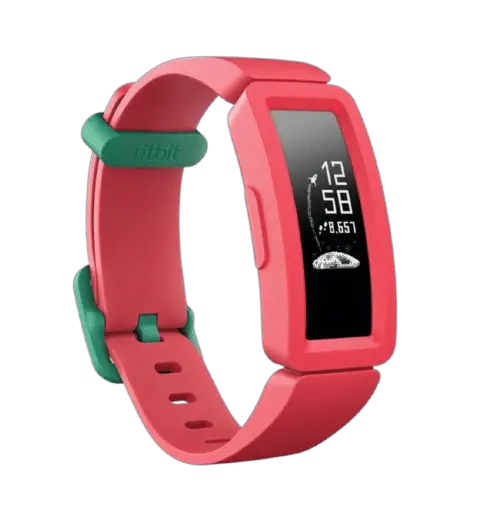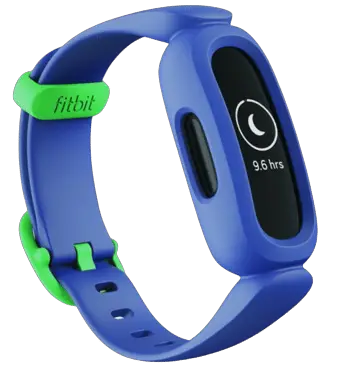For years, Fitbit has been on the lead in designing some of the best smartwatches and fitness trackers in the world. And having expanded their reach to accommodate kids as young as 13 years of age, even children can now benefit from the brand’s innovation.
The best Fitbit for kids is the one that motivates teens to take at least 250 steps an hour to reach the recommended 60 daily active minutes. Models equipped with sleep trackers and silent alarm can help kids develop optimal sleeping habits for healthy growth.
In addition, Fitbit models with features such as female health tracking, SmartTrack, and heart rate sensors are good for older, more active that can do more than the 60 minutes of daily activities.
5 Best Fitbit for Kids
If you’re in a hurry and just wants a list of recommendation of Fitbits that you can buy as a gift for your boy or girl, here are your options.
| Fitbit Ace 2 | Fitbit Ace 3 | Fitbit Versa 3 |
| Age: 6+ years | Age: 6+ years | 13+ years |
| Waterproof, on-screen badges and celebrations, and up to 5 days battery life | Animated clock faces, all-day activity tracking, and up to 8 days battery life | Female health tracking, built-in GPS, and up to 6 days battery life |
 |  |  |
| Buy Now | Buy Now | Buy Now |
In this guide, we’ll look at the combination of features that make the best Fitbit for young children and teenage boys and girls to help you choose what’s more appropriate for your kid(s).
How to Choose a Fitbit for Kids (7 Features & Why They Matter)
Fitbit hasn’t designed many fitness wristbands for the younger audience.
However, the currently available options are good enough to help your kids get moving and developing healthy habits.
The following are 7 featuresto look at when hunting for a kid’s Fitbit to ensure you pick the right device for your child.
1. Step Tracking
Sleep tracking is one of the most important feature to look at when shopping for the best Fitbit for kids.
In fact, the ability to use Fitbit to track sleep makes it possible you to determine whether your child is getting enough rest during their bedtime hours.
By checking your child’s sleep stages of the current data and comparing that with previous stats, you can help them to develop better sleeping habits for healthy growth.
2. Waterproofing
If you have a kid that loves to go swimming, get them a waterproof Fitbit.
Let me explain:
A fitness tracker or smartwatch with a 5 ATM calibration can stand up to water splashes and submersions to a depth of 50 meters.
It follows therefore that water can hardly ruin the optimal performance of such a device. But keep in mind that long-term use of the tracker in moist environment will downgrade its quality over time.
More importantly, ensure the Fitbit you select has the ability to track swimming. Lap and stroke stats can be a good motivation for older kids that take workouts seriously.
3. Fun Challenges
From where I sit, younger kids need some type of motivation to remain engaged to activities.
Fitbit does this quite well by incorporating fun challenges into the trackers that it built specifically for the younger audience.
With the ability to engage an entire family to challenges in step competition, Fitbit Ace 2 and Ace 3 can get the whole family to encourage kids to get at least 60 minutes of physical exercise every day.
4. Battery Life
It’s easy to become obsessed with performance features of a fitness tracker so much that you ignore its runtime.
But battery life is an equally significant consideration to make.
It’s easy when it comes to Fitbit, though, as the brand ensures its devices have a longer runtime on a single charge.
For example, Fitbit Ace 3 has an estimated battery life of 8 days, although how longer the battery actually lasts depends on active features and frequency of use.
The bottom line is:
Find a Fitbit that your kids would spend less time charging and more time using, so they can easily build an active lifestyle.
5. Heart Rate Monitor for Older Kids
A heart rate sensor is one of the significant features in a smartwatch and fitness tracker, and one that I recommend you consider when looking for a kids’ Fitbit.
The heart rate monitor built into a Fitbit is an important technology that determines the variation of time between each of your child’s heartbeat.
To be clear, Ace 2 and 3 don’t have built-in heart rate sensors. So if you decide that the feature is a must-have, consider one of the other models with built-in HR technology.
6. Reminder to Move
The Reminder to Move is an important feature that can get younger children and teenage kids to stay active on a daily basis.
A Fitbit with this feature built-in would be more appropriate as it naturally gets youngsters to get on the move, feed the device with steps, and build a healthy lifestyle.
Remember, your kids need to get at least 60 minutes of daily physical activity to grow fit. As such, a Fitbit with the Reminder to Move feature can make a big difference.
7. Female Health Tracking for Girls
Girls start their periods from 12 years of age.
So if you have a daughter to whom you’d like to gift a Fitbit, wouldn’t it be great if you bought them one that include female health tracking?
The goal of this feature is simple:
It allows you to collect data about your child’s period and ovulation, making it easy for you to understand how your teenage girl’s cycle and related symptoms change from month to month.
Currently available only on selected devices, the female health tracking is a feature you can enable during account setup, or completely ignore altogether.
Frequently Asked Questions
1. Can Kids Wear Fitbit?
Kids can wear Fitbit activity trackers as motivation to develop healthy habit by leading an active lifestyle.
Features such as Reminder to Move, Fun Challenges, and Celebratory Badges can keep kids active for the recommended duration, hence a healthy lifestyle .
What’s more?
Like adults, kids can equally benefit from Fitbit’s advanced features such as:
- Heart rate monitor that counts calories burned
- SmartTrack that automatically detects and logs workouts
- Sleep sensors that helps determine the quality of sleep
- Silent vibrating alarms that can help kids wake up early for school or weekend chores
To be abundantly clear, Fitbit aren’t a must-have for anyone, and kids aren’t an exception.
But because they can help anyone develop and grow a healthy lifestyle, buying your child a Fitbit can be a great idea.
2. What Age is Fitbit Ace 2 and 3 For?
The Fitbit Ace 2 and Fitbit Ace 3 are suitable for kids aged 6 years and up.
Apparently, Ace 2 and 3 are the only two models built specifically for kids. And they portray Fitbit as a brand that cares about the wellbeing of everyone regardless of their age.
3. Can You Setup Fitbit Inspire 2 for a Child?
You can set up Fitbit Inspire 2 for a child through the family account.
- Login to your Fitbit family account
- Create a child account within the family account
- Log to the account you just created for your child and set up the device
- Now log back to the family account and use it to manage the kids account
Remember that due to safety regulations, Fitbit doesn’t allow kids to have their own dedicated accounts until they are 13 years of age.
4. Will the Fitbit Inspire 2 Fit a Kid?
Fitbit Inspire 2 may or may not fit a kid depending on the size of their wrist. You’d need to try it out first on them to determine whether the model would be suitable for them.
Alternatively, you can get interchangeable bands compatible with Inspire 2 and modify it to fit small wrists.
These bands are available for cheap online.
Final Thoughts
Fitbit hasn’t designed many models for kids, but what’s available is good enough to get the youngsters moving and building an active and healthy lifestyle.
It’s equally possible to repurpose Fitbits used by adults as options for children, particularly if there are features you believe would be useful for children.
For example, Fitbit Charge 5 may not have teenagers as the target audience. But its stress management tools are equally helpful to this ground, so repurposing makes sense.
For what it’s worth, I believe the Fitbits discussed in this guide can help your child build the kind of active lifestyle that other forms of motivation wouldn’t get them to do otherwise.

